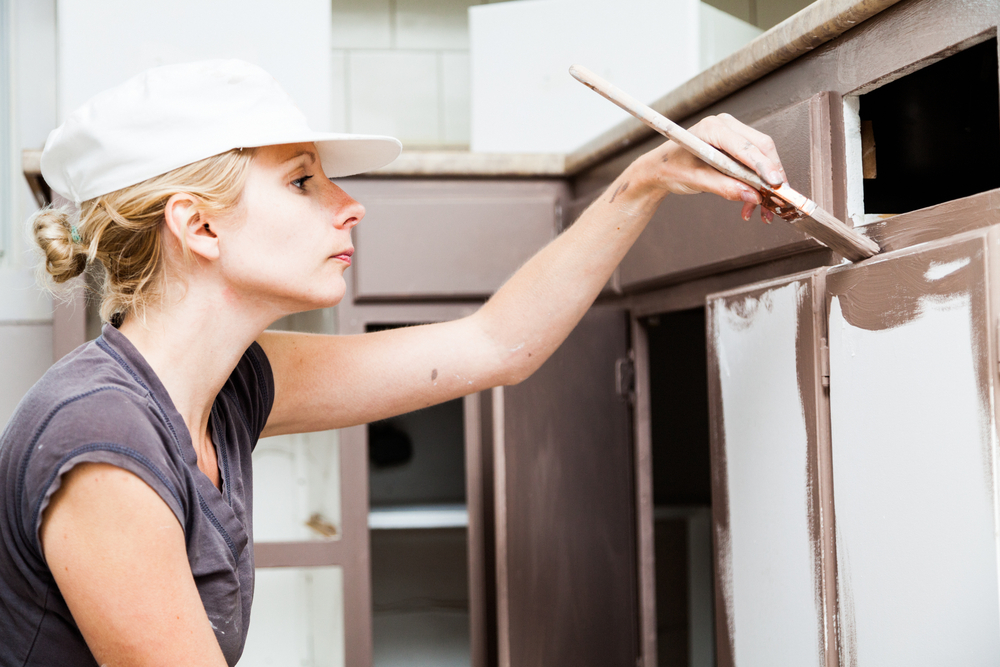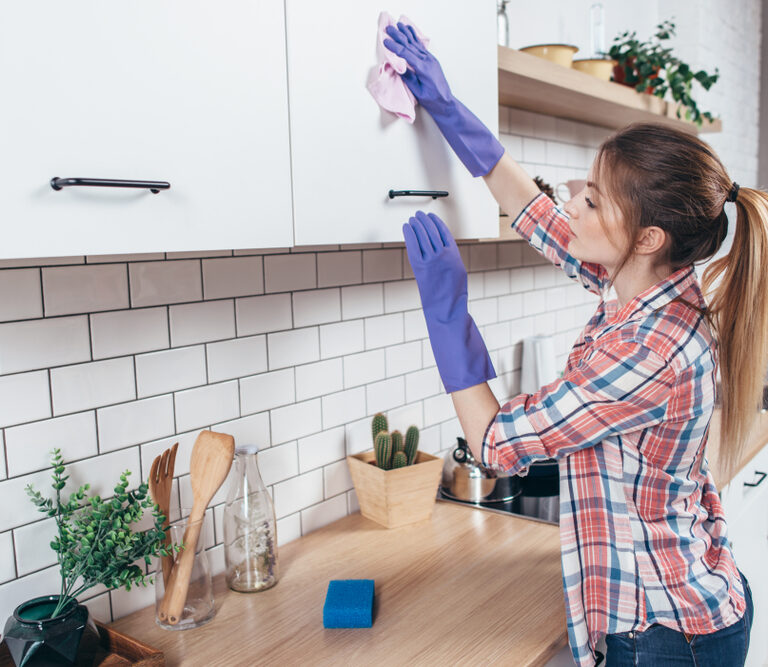Considering that they’re one of the busiest (and most expensive) parts of your kitchen, cleaning and maintaining your kitchen cabinets can be the difference between having cabinets that last for years or ones that fall into disrepair.
Cleaning cabinets is also important prior to home renovation projects like panting or refinishing cabinet doors. The best way to clean your kitchen cabinets depends largely on why you’re cleaning them.
Regular Kitchen Cabinet Cleaning
Even if you rarely cook in your kitchen, all surfaces in the room, including your cabinets, will collect dust. And if you use your kitchen every day or, like most people, multiple times per day, your kitchen cabinets are not only gathering the same type of dust as every other room but also cooking grease, grime, and food crumbs.
If it’s been a while since you’ve cleaned the inside or outside of your kitchen cabinets, they likely will need a more thorough going-over, and you can find the steps for that later in this article. But if you’ve inspected or recently deep cleaned your cabinets, now is the perfect time to establish a cleaning routine for the inside and outside of your kitchen cabinets.
The kitchen cabinet doors will need more attention than the interiors, and open shelves or cabinet boxes without doors should be treated the same as the outside of cabinet doors. Here’s a look at some good habits to get into so you can keep your kitchen cabinets looking fresh all the time:
Every Day
If you cook multiple meals in your kitchen every day, try getting into the habit of giving the cabinet door fronts and exposed surfaces near the sink and cooktop a wiping every day. Take a lightly damp paper towel or soft cloth and wipe these surfaces. If they are particularly dirty, use a bit of dish soap on the cloth.
Obviously, the more cabinets you have, the longer this will take, so if time is an issue, consider wiping upper cabinets in the morning and lowers in the evening, or base your schedule on zones.
Remember that surfaces near where food is chopped or cooked and where water is present (sink, water dispenser, dishwasher) will be the areas that need the most attention. If you cook less frequently and your kitchen doesn’t get much action, doing this once or twice a week should be sufficient.
Seasonally
About every quarter, clean out the inside of your kitchen cabinets. They aren’t prone to accumulating grease and grime as the cabinet door fronts are, but they still manage to gather dust and crumbs.
- Remove all the items from the cabinets
- Wipe down the cabinet and drawer interiors with a lightly damp cloth or paper towel
- Use a vacuum cleaner (a portable option with a slim nozzle is ideal for this) on tough-to-reach areas where you notice dust or dirt has gathered; a flashlight can be helpful for illuminating corners of cabinets.
You can also take this as an opportunity to reorganize cabinets or drawers if things have become misplaced. Any cabinets that are used to store dry goods or bulk food items should get a thorough inventory so items can be replaced if needed and expired products can be tossed.
Deep Cleaning Your Kitchen Cabinets
While regular cleaning routines can help you prevent the buildup of grease, grime, and crumbs that can make a deep cleaning necessary, chances are you’ll have to do that at least once or twice a year. The steps are basically the same, but you’ll need to use more aggressive cleaning substances and techniques.
Here are the steps to deep cleaning cabinets without removing the finish; if you’re planning to paint or refinish them, skip to the next section.
Step One: Make a Cleaning Solution
Most commercial kitchen cabinet cleaners are geared toward preserving the finish of wood cabinets. While they certainly have their place, they just aren’t designed to gently remove grease or food debris from the inside or outside of kitchen cabinets.
But the good news is that with just a couple of common household ingredients, you can easily make your own cleaning solution for your cabinets (and many other surfaces in your house that need a firm but gentle touch). This is most easily done using a spray bottle, but a large bowl would also do the trick.
Mix one part dish soap with two parts hot water, or the same ratio of hot water to distilled white vinegar.
Step Two: Wipe Down the Cabinet Doors, Handles, and Knobs
Rather than spraying the solution directly on the cabinet or drawer fronts, lightly spritz a soft cloth or paper towel and use that to wipe the doors, drawer fronts, and cabinet hardware. Be sure not to get anything too wet, as this can damage the cabinets’ finish.
If you’re using a bowl instead of a spray bottle, dip the cloth but make sure to wring it thoroughly so it’s not soaked. Tough spots with seriously stuck-on grease can be cleaned with a mixture of equal parts baking soda and water.
Step Three: Empty the Cabinets and Clean the Insides
Using the same method as above, wipe down the interiors of all cabinets and drawers as well as any open shelving you might have. Take the opportunity to rid yourself of any items in your cabinets that you no longer need or return them to their proper home if they’re misplaced.
Grab a flashlight to illuminate all corners and use a vacuum for hard-to-reach areas where dust or debris has gathered.
Step Four: Wipe Everything Clean
Once you’ve finished cleaning using your homemade solution, take a separate damp soft cloth or paper towel, and go over every surface to remove any cleaning solution that’s remaining on the cabinet doors, drawers, or interiors.
Step Five: Don’t Let Them Air Dry
Air drying the fronts or insides of the cabinets or drawers can damage the finish, even causing paint to bubble or flake off. With another soft cloth or paper towel, this time a dry one, do a final wipe to ensure everything is completely dry. A soft buffing of the cabinet door finish can help restore their shine.
Step Six: Pay Special Attention to Glass
If you have open shelving or any cabinet doors that have glass panes, be sure to clean both sides of the glass and get into corners to remove all grime and dust. Again, avoid using harsh abrasives that can scratch the glass.

Preparing for Paint
The two methods described above will be plenty to handle the normal wear and tear your kitchen cabinets experience on a regular basis. But for those who are planning to tackle one of the most popular DIY projects (painting their cabinets), a few more steps are necessary to help create a professional look.
You can learn more about the steps for painting your cabinets here, but thoroughly cleaning all surfaces is crucial to this process.
Use a Harsh Cleaner
One key difference between regular/deep cleaning and getting your cabinets ready for paint is that when you clean the surfaces, you’ll need to use a harsher cleaning solution. Even if your cabinets have been regularly cleaned with your homemade cleaning solution, any grease or grime that remains on the surface will make it difficult to achieve a smooth finish.
For this reason, it’s recommended that you clean all surfaces with a trisodium phosphate (TSP) cleaner. This material can be hazardous if it gets in your eyes or on your skin, so be sure to use safety glasses and gloves when dealing with any type of TSP cleaner. These products can be found in powder form that needs to be mixed with water, or you can choose one that’s premixed.
TSP Alternatives
TSP alternatives are available, though they may be slightly less effective and require more elbow grease to fully prepare the surface. In addition to removing any stuck-on grease or grime, the purpose of cleaning the cabinets before painting is to remove any gloss from the existing paint or finish. A popular TSP alternative for painting cabinets is this Krud Kutter TSP substitute.
Follow the Standard Deep-Cleaning Steps
All other steps and tips apply, as you’ll need to be sure you’re cleaning but not soaking the cabinets. All surfaces will need to be thoroughly dry before priming and painting can begin.
Once your cabinets are completely clean, choose your paint and get started!
Cleaning Wood vs. Laminate or MDF Cabinets
Many modern kitchens have cabinets made from a combination of wood and laminate products such as MDF (medium-density fiberboard). In most cases, your cleaning methods should be the same, but it’s good to make sure that you understand what every surface of your kitchen cabinets is made from. That’s because MDF can be more sensitive to pooling water than wood.
However, MDF is generally smoother than wood, so it’s typically a bit easier to clean, as you don’t have to contend with a wood grain.
Kitchen Cabinet Maintenance Tips
If you can get yourself in the habit of doing regular quick cleanings of your cabinets, chances are you’ll never have a problem with them. But there are a few other aspects to watch out for:
Use Soft Materials
Paper towels are generally sufficient, but you wouldn’t want to use anything stiffer than that. And, in fact, the softer the better, so cheesecloth, flour sack, microfiber, and others that are lint-free are ideal. Whatever you use should be new or recently laundered so you’re not just wiping old residue onto the cabinets.
Keep Wet Towels off Cabinets
Having a large supply of cloth towels is better for the earth than using paper towels for everything in the kitchen, but if towels are hung from cabinet handles while they are still wet, there’s nothing to stop the cabinet door or drawer front from being exposed to moisture. Over time, this can cause stains and other damage to the door.
Consider a hanging towel rack for the kitchen and make sure your kitchen towels are laundered regularly.
Take Care of Spills or Drips Right Away
Preparing and cooking food can be messy work, and especially for cabinets near cooktops or ovens, splatters and drips are a constant reality. If you notice something has dripped onto the cabinet, even a tiny amount, put some soap and water on a dishrag or even the kitchen sponge and wipe it away. This will save you time and effort down the road.
Enjoy Your Grime-Free Kitchen Cabinets
The kitchen is the heart of the home, so take the time to care for it properly. By regularly wiping down, deep cleaning, and maintaining your cabinets, you can ensure that they’ll last for years to come. Keep our tips in mind, and cleaning your kitchen cabinets should never be a stressful ordeal.
